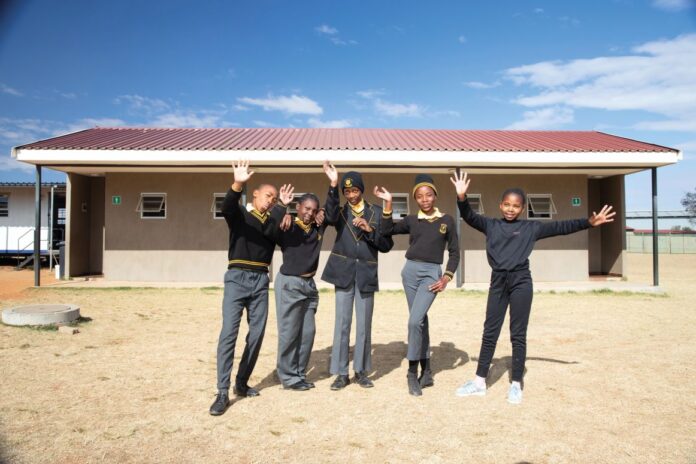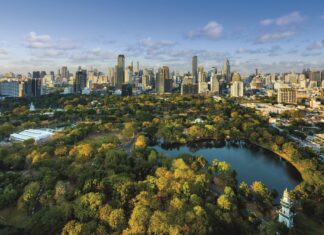IWA’s Resource Recovery from Water Cluster presents the results of its 2025 Best Practice Award.
The objective of the IWA Resource Recovery Cluster Best Practice Award is to raise awareness of existing solutions to effectively recover resources from water and wastewater, providing an alternative and economical source of resources and reducing water stress through a more circular approach. The process of recovery within the water cycle can yield valuable resources, including reclaimed water, energy, and precious nutrients and metals.
The Cluster received a high number of applications for its latest edition, and the award was presented at the 6th IWA International Resource Recovery Conference in Leeuwarden, Netherlands, on 19-23 May. The selected winning paper, ‘Resource Recovery from Wastewater: Onsite Reuse Through Water-Efficient Sanitation Systems (WESS) in Schools and Rural Communities,’ was presented by the Water Research Commission (WRC), South Africa.
Sustainable sanitation technologies
WRC’s South African Sanitation Technology Enterprise Programme (SASTEP) is accelerating the adoption of Water-Efficient Sanitation Systems (WESS) and Non-Sewered Sanitation (NSS) technologies, with many of them originating from the Re-invent the Toilet Challenge (RTTC) initiative by the Gates Foundation.
These systems reduce water consumption by treating and reusing wastewater onsite. Implemented in schools, informal settlements, and communities, these technologies not only address water scarcity but also recover nutrients, produce energy, and create new value streams from human waste.
Unlike traditional sewered sanitation, WESS (NSS) operates independently of centralised sewer networks and municipal wastewater treatment plants. WESS redefines sanitation from a centralised infrastructure and treatment model to a distributed infrastructure model and a centralised service model. This should be seen as a potential precursor stage to full household reinvented toilet (RT) systems (i.e. standalone full treatment systems at household level).
WESS has important components determining the technologies or systems used, the service models applied, and the eventual reuse or use of the products recovered.
Systems demonstrated under the SASTEP platform are:
- Clearwater WESS/NSS/RT – A biological-membrane full recycle system producing effluent water that is reused for flushing.
- NEWgenerator WESS/NSS/RT – A biological-electro-chemical full or partial recycle system producing effluent water reused for flushing, nutrient rich water for irrigation, and biogas (not captured due to the small quantities produced).
- Aquonic WESS/NSS/RT – A biological-biofilm full or partial recycle system producing effluent water for reuse for flushing and irrigation in some instances.
- Dewdrop WESS/NSS/RT – A nature-based biological treatment system producing effluent water that is reused for flushing.
- In addition, a series of low-flush or water-efficient toilet pedestals were demonstrated.
Centralised service models recommended and tested for local employment scenarios include:
- The social franchising model, which uses a skilled technical service provider to build and standardise skills in local communities and allow the franchisor to service technologies in communities.
- The user paid model, which is a business-to-customer model that provides a sanitation facility with a safe mechanism for removal of sludge for a monthly fee (with capital and operating expenditure built into the monthly payments), which treats sludge centrally.
- The performance-based contract with aggregated and centralised services using a qualified service provider for all of the distributed technologies.
The multiple use services model and community-led sanitation models, which can be used but require full ownership and pre-requisite skills from the community itself.
Potential for recovered resources
The products that it is possible to derive from this technology include:
- Blackwater treated to a standard fit for recycling as flush water.
- Blackwater treated to a standard fit for irrigation, with effluent used as liquid fertiliser.
- Yellow water for use as liquid fertiliser or centralised for treatment in a struvite reactor.
- Sludge treated for use as soil conditioner.
- Blackwater treated with a process that generates biogas.
Facilitating commercialisation
The success of WESS (NSS) in South Africa is driven by a collaborative effort involving government agencies, development banks, private sector partners, researchers, funders, and communities. WRC plays a key role, aligning stakeholders towards a common country level vision. And SASTEP plays a key role in facilitating the localisation and commercialisation of the technologies, working with commercial partners. In addition, the National Department of Basic Education (DBE) and local municipalities deploy the technologies in schools and in the community.
Private sector partners are responsible for manufacturing, installing and operating these systems, contributing to local job creation. And the Department of Water and Sanitation supports WESS and NSS by integrating these systems into policies, norms and standards. Similarly, the South African Bureau of Standards (SABS) has aligned ISO 30500 with SANS 30500, enabling certification of WESS and NSS under this standard.
Reaching those underserved
The modular, water-efficient, scalable design allows for deployment in water-scarce, underserved areas. By shifting from a disposal-based approach to a resource recovery model, these innovations present a sustainable, cost-effective solution that aligns with circular economy principles, making sanitation more resilient and adaptable to climate challenges. User acceptance surveys indicate high satisfaction with both WESS and NSS. In addition, schools that have hosted demonstrations of the improved sanitation services have noted a reduction in absenteeism.
School rollout
SASTEP has successfully demonstrated WESS and NSS technologies in 12 schools and three communities, leading to further adoption by the DBE, which has financed their implementation in 48 additional schools. Furthermore, the Water Partnerships Office, hosted at the Development Bank of Southern Africa (DBSA), will support the preparation of bankable WESS/NSS projects for municipalities and the DBE, enabling wider rollout and long-term sustainability under a country-wide steering group.
Commenting on the winning initiative, co-Chair of the Cluster, Prof. Ana Soares, said: “We highly appreciate the truly holistic approach presented by the WRC team. It’s a great example of the application of an innovative concept.”
More information








